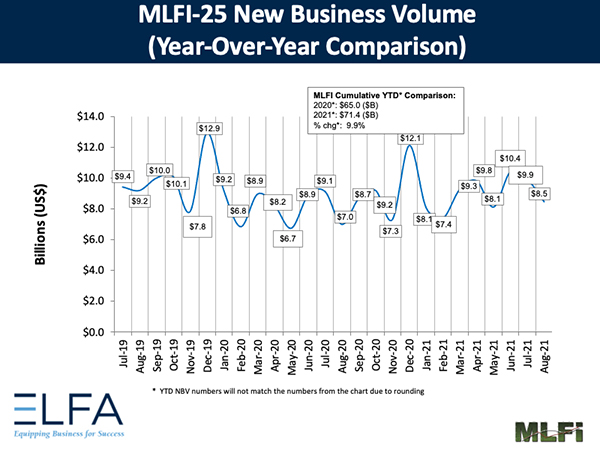ELFA’s Monthly Leasing and Finance Index for August shows new business volume of surveyed member companies was up 21% year over year.

Washington, DC — The Equipment Leasing and Finance Association’s (ELFA) Monthly Leasing and Finance Index (MLFI-25), which reports economic activity from 25 companies representing a cross section of the $900 billion equipment finance sector, showed their overall new business volume for August was $8.5 billion, up 21 percent year-over-year from new business volume in August 2020. Volume was down 14 percent month-to-month from $9.9 billion in July. Year-to-date, cumulative new business volume was up 10 percent compared to 2020.
Receivables over 30 days were 1.8 percent, down from 1.9 percent the previous month and down from 2.4 percent in the same period in 2020. Charge-offs were 0.23 percent, up from 0.18 percent the previous month and down from 0.75 percent in the year-earlier period.
Credit approvals totaled 76.3 percent, down from 76.5 percent in July. Total headcount for equipment finance companies was down 14.1 percent year-over-year, a decrease due to significant downsizing at an MLFI reporting company.
Separately, the Equipment Leasing & Finance Foundation’s Monthly Confidence Index (MCI-EFI) in September is 60.5, a decrease from the August index of 66.6.
ELFA President and CEO Ralph Petta said, “August data show some softness in equipment demand resulting from a mix of summer doldrums, continued supply chain disruptions and lingering pandemic-related woes. Business optimism, which peaked earlier in the summer, also has waned somewhat. However, when compared to where the economy and equipment finance business were a year ago, with the COVID-19 virus raging throughout the country, August new business volume is wholly acceptable.”
Jeffrey Hilzinger, President and CEO, Marlin Capital Solutions, said, “2021, while much better than 2020, continues to be a challenging period for the equipment finance industry. While demand for equipment remains strong, August was the second consecutive month of reduced origination volume for the industry. Supply chain issues continue to be a key driver underlying this trend and seem to have worsened in recent months. On the positive side, approval rates have remained at pre-COVID levels and portfolio delinquencies and charge-offs remain at historically low levels.”
About ELFA’s MLFI-25
The MLFI-25 is the only index that reflects capex, or the volume of commercial equipment financed in the U.S. The MLFI-25 is released globally at 8 a.m. Eastern time from Washington, D.C., each month on the day before the U.S. Department of Commerce releases the durable goods report. The MLFI-25 is a financial indicator that complements the durable goods report and other economic indexes, including the Institute for Supply Management Index, which reports economic activity in the manufacturing sector. Together with the MLFI-25 these reports provide a complete view of the status of productive assets in the U.S. economy: equipment produced, acquired and financed.
The MLFI-25 is a time series that reflects two years of business activity for the 25 companies currently participating in the survey. The latest MLFI-25, including methodology and participants, is available at www.elfaonline.org/Data/MLFI/.
MLFI-25 Methodology
ELFA produces the MLFI-25 survey to help member organizations achieve competitive advantage by providing them with leading-edge research and benchmarking information to support strategic business decision making.
The MLFI-25 is a barometer of the trends in U.S. capital equipment investment. Five components are included in the survey: new business volume (originations), aging of receivables, charge-offs, credit approval ratios, (approved vs. submitted) and headcount for the equipment finance business.
The MLFI-25 measures monthly commercial equipment lease and loan activity as reported by participating ELFA member equipment finance companies representing a cross section of the equipment finance sector, including small ticket, middle-market, large ticket, bank, captive and independent leasing and finance companies. Based on hard survey data, the responses mirror the economic activity of the broader equipment finance sector and current business conditions nationally.
About ELFA
The Equipment Leasing and Finance Association (ELFA) is the trade association that represents companies in the nearly $1 trillion equipment finance sector, which includes financial services companies and manufacturers engaged in financing capital goods. ELFA members are the driving force behind the growth in the commercial equipment finance market and contribute to capital formation in the U.S. and abroad. Its 580 members include independent and captive leasing and finance companies, banks, financial services corporations, broker/packagers and investment banks, as well as manufacturers and service providers. In 2021, ELFA is celebrating 60 years of equipping business for success. For more information, please visit www.elfaonline.org.
Follow ELFA:
Twitter: @ELFAonline
LinkedIn: www.linkedin.com/groups?gid=89692
Facebook: www.facebook.com/ELFApage
ELFA is the premier source for statistics and analyses concerning the equipment finance sector. Please visit www.elfaonline.org/Data/ for additional information.
The Equipment Leasing & Finance Foundation is a 501c3 non-profit organization that propels the equipment finance sector—and its people—forward through industry-specific knowledge, intelligence, and programs that contribute to industry innovation, individual careers, and the overall betterment of the equipment leasing and finance industry. The Foundation is funded through charitable individual and corporate donations. Learn more at www.leasefoundation.org.
Media/Press Contact: Amy Vogt, Vice President, Communications and Marketing, ELFA, 202-238-3438 or avogt@elfaonline.org
In this episode, I sat down with Beejan Giga, Director | Partner and Caleb Emerson, Senior Results Manager at Carpedia International. We discussed the insights behind their recent Industry Today article, “Thinking Three Moves Ahead” and together we explored how manufacturers can plan more strategically, align with their suppliers, and build the operational discipline needed to support intentional, sustainable growth. It was a conversation packed with practical perspectives on navigating a fast-changing industry landscape.